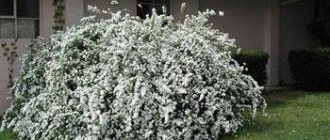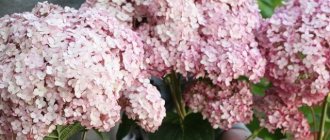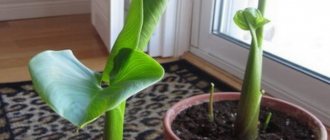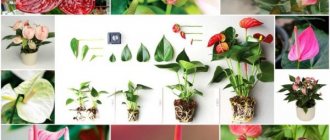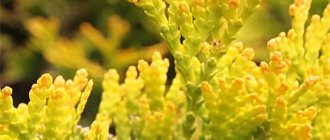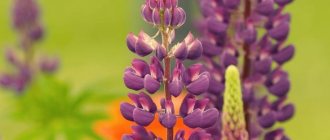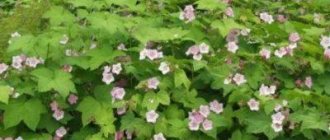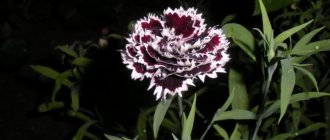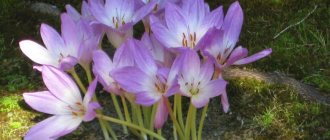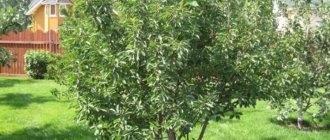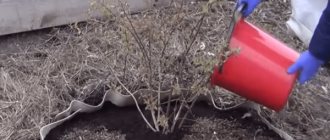Planting in open ground
The ornamental plant is one of the most unpretentious of flowering shrubs. Hydrangea can grow in almost any soil. The culture grows in partial shade and sunny areas. However, for abundant and bright flowering, it is still advisable to take into account its preferences in conditions.
When is the best time to plant
In regions with early winters, hydrangeas are best planted in late summer. Before frost, the seedling will have time to take root. In the central and southern regions, spring planting is recommended, when the soil has warmed up to +8°C. In mid-late April there is no longer a threat of return frosts; nothing threatens the young plant in the open ground.
Selecting a location
Choosing the right site is half the success. Ideal conditions for the development of hydrangea are bright light in the morning and evening, light shade during sunny hours. When grown in constant shade, the inflorescences will be loose and the plant will quickly fade. Sunny places are great, but at midday the aggressive sun will burn the delicate petals and foliage. Given the root system located close to the soil surface, the crop needs protection from gusty winds, especially at a young age.
Important! Seedlings that do not have time to grow roots can be torn out by a strong gust of wind.
Preparing seedlings and soil
Before planting, you need to prepare the seedling:
- Check and remove weak, broken roots.
- Make sure that the root shoots are almost the same length; shorten those that are too prominent.
- Maintain the bush in the Heteroauxin solution for 24 hours (2 tablets per 10 liters of water). Do not throw away the solution after use (see below).
After digging the planting hole, the soil extracted from it is mixed with humus, compost and river sand in a ratio of 2:2:1:0.5. The size of the hole is adjusted to the volume of the root system.
Disembarkation process
After preparing the bush, inspect its roots again for damage.
Planting technology:
- Drainage made of gravel or pebbles or broken bricks is placed at the bottom of the hole. Layer approximately 10 cm.
- A hill is poured on top, slightly higher than the length of the roots.
- Place the plant, straighten the root shoots and sprinkle with prepared soil.
- When adding soil, it must be compacted to prevent voids.
- The root collar remains above the surface 7–10 cm higher.
- Newly planted plants are watered with a bucket of water and a solution in which the roots were soaked.
How to organize a winter camp
Hydrangea needs special shelter if the climate zone is characterized by prolonged frosts with air temperatures below -20°C. Young specimens under three years of age must be insulated.
Gardeners use different methods for insulating young and mature shrubs. The tops of the branches of young seedlings are carefully tilted towards the ground and fixed in this position using pegs from a rope. The base of the bush is hilled up, sprinkled with peat, sawdust, and fallen leaves. Then cover the plant with roofing felt and lutrasil. The edges of the covering material are fixed with boards. Three-year-old hydrangeas are covered in the same way. A hut made of spruce branches is arranged on top of the covering material or a pile of dry sawdust is poured.
Experienced gardeners place pickled grain under the base of wintering hydrangea to protect the plant from rodents. Adult five-year-old bushes are insulated differently. Because they are difficult to bend to the ground. The tops of the branches are loosely tied with twine. The resulting cone is wrapped in lutrasil. The insulation is fixed using tape or a stapler. A flexible metal mesh is installed around the perimeter. Sawdust, pine needles, fallen leaves, and spruce branches are loosely poured inside the mesh cone.
https://youtube.com/watch?v=E5mVPlXFF6U
How to care for a beautiful bush
For unpretentious Annabelle, planting and care is a simple matter. Its high ability to take root and grow in almost all places makes the shrub universal. It tolerates winters easily, except in the northern regions. There, even mature bushes should be protected with shelter during the coldest period of the year. True, there are still small details that should be taken into account. The most appropriate time for planting is late spring or early autumn.
The location should be selected according to the following criteria:
- be well lit, but not in direct sunlight (Annabelle can survive in the shade, but her growth rate will be significantly reduced, as will the brightness and splendor of flowering);
- do not be in drafts;
- the soil should be highly acidic and well drained (the plant cannot tolerate stagnant water).
Annabelle likes regular watering. At the same time, the development of the bush and flowering activity will always be at the highest level. Therefore, during dry periods, you should not forget about watering. The plant does not accept excessive drying out or too much water, just as it does not respect weeds. Loosening the soil around this type of hydrangea is one of the types of pleasant attention that it will certainly appreciate.
Planting and care include such important points as fertilizing and proper pruning. This plant loves organic and mineral fertilizers. The best stages for carrying out these manipulations will be the autumn-spring period. In principle, it does not tolerate lime and ash. While there are buds on Annabelle, you should not fertilize it, otherwise the flowers on it will turn green. Like other tree-like plants, it needs pruning to form a rounded crown.
During the autumn period you should:
- remove dry branches;
- collect dried inflorescences;
- shorten young shoots by 1/3 to 10 pieces from the entire bush, and cut off the rest completely.
All of the above applies to shrubs whose age has already exceeded 3 years.
Hydrangea tree Annabelle has fairly wide roots. Therefore, the landing pit should not be so deep as it should be wide. If you decide to decorate the garden with several bushes in a row, creating a hedge from them,” when planting, you should maintain a distance between them. It should not be less than 1.5 meters. Planting is carried out exclusively in a moistened and fertilized hole. An admixture of sand and leaf soil is allowed.
The root collar of the shrub should not be covered with soil; it is better to be level with the ground. Mulching the root circle is an important point. It is carried out using peat and sawdust. At first, the inflorescences of a young bush should be cut off. The purpose of the manipulation is to strengthen the bush. Strength must first go into growth and only then into flowering.
Characteristic
About 35 species of deciduous shrubs belonging to the genus of flowering plants of the hydrangea family grow on different continents. Hydrangea, or hydrangia (hudrangea) is translated from Latin as “vessel of water.” During the growing season, the bush evaporates a lot of water and, if there is not enough water, quickly withers.
Several types of hydrangea are usually grown in gardens: paniculate, tree-like, large-leaved. Plants attract attention with large inflorescences in the form of a ball or panicle, and large green leaves. Flowers in a bud are of 2 types: in the middle - small, fruit-bearing, at the edges - large, barren. The fruit of hydrangea is a capsule with many small seeds.
Hydrangea tree Annabelle is a beautiful shrub with a height of 1 to 2 meters. It does not have very thick pubescent shoots. The leaves, attached to the branches by long petioles, are arranged oppositely. In mid-July, large inflorescences appear on the shoots.
The bush is up to 1.5 m high, the crown width is up to 3 m. Its leaves are rich green, oval, with a pointed end, retaining their bright color until frost. Hydrangea Anabel blooms at the end of June with white buds and stays like that until September. The inflorescence is dense, consisting of many small white flowers. Its length reaches 20-25 cm. This variety is not capricious, resistant to unfavorable climatic conditions, and can grow even in Siberian conditions. In one place, a bush can grow up to 50 years without losing its decorative appearance.
Hydrangea Annabelle (in the garden)
Note! This type of hydrangea can change the color of the inflorescences. To obtain a blue color, it is mulched with peat, spruce litter, and also fed with a solution of aluminum alum; for pink, large doses of phosphorus fertilizer are applied.
Hortense Strong Anabel is one of the varieties of Anabel. The height is the same, but the flowering is much more abundant: at this time almost no foliage is visible under the balls. The variety tolerates frost well and is resistant to diseases.
Hydrangea Pink Annabelle has pink flower heads. At first dark pink, over time the color changes to lighter. The shoots of the bush are powerful, strong, and do not bend towards the ground even during the period of abundant flowering. The compact shape of the bush is maintained throughout the season.
Care
In order for “Pink Annabelle” to feel comfortable and bloom profusely, it is necessary to provide her with competent care. First of all, it should be said about watering. It should be noted that hydrangeas are extremely moisture-loving, so they need regular and abundant watering. The soil should not dry out. It should be noted that the plant can live without moisture for a long time, however, this will certainly affect its appearance. The leaves and flowers will simply wither. Therefore, during drought and on hot summer days, you need to water the bush 2 times a week, and under normal conditions - weekly.
Mulching the root circle will retain moisture in the ground much longer. Mulch will prevent its evaporation. You can use pine needles or chopped bark. Organic matter helps acidify the soil, which will definitely benefit hydrangeas. Its layer should be about 8-10 centimeters. After decomposition, the organic material will become an excellent food for the flower.
You should also definitely pay attention to fertilizing. During the growing season, spring and autumn, “Pink Anabel” will need more nutrition.
Its role can be perfectly performed by both organic and mineral fertilizers. You can also use a composition designed specifically for flowering plants. It contains all the necessary components.
It is most convenient to purchase the compositions initially in liquid form. Before treating the plant with them, it will be enough to dilute them with water in the required proportions.
Hydrangea must be treated with a solution of potassium permanganate 3 times per season. This is an excellent preventive measure against attacks by harmful insects. This procedure is especially relevant when it comes to young and tender bushes.
Pruning should not be overlooked either. It is with its help that the appearance of the bush is formed. The procedure should be carried out from the first years of the plant’s life. However, until the age of three, she should have the most gentle regimen possible.
Pruning can be done in the spring, however, it is necessary that the movement of sap has not yet begun. It is also not forbidden to carry out the procedure in the autumn, when the plant has already faded. In addition, you need to take into account that it is also recommended to cut off the first inflorescences on young bushes, this will lead to more abundant flowering in the future.
Features of cultivation and care
Before growing tree hydrangea, you need to familiarize yourself with the features of caring for the plant. By following the simple rules of agricultural technology, the ornamental shrub will delight you with abundant flowering every year.
Soil selection
It is not recommended to plant hydrangea in alkaline soil. The shrub will grow well on slightly acidic and acidic loams. A small amount of lime will not harm the plant. You can acidify the soil substrate using sawdust, peat and pine bark. This must be done 6 months before planting the crop.
Location and lighting
Ornamental shrubs should be planted immediately in a permanent place, since frequent transplants are not recommended. Hydrangea takes a long time to adapt to a new area.
Experts advise when choosing a location to consider the following features:
- abundant, diffuse lighting. The scorching rays of the sun should be avoided. Otherwise, the petals of the inflorescences will lose their original color - they will “burn out”, and the flowering period of the hydrangea will decrease by 3-5 weeks. It is also better not to plant in the shade. With a lack of sunlight, the inflorescences and petals become smaller;
- protection from wind and draft. When there are gusts of wind, shoots with heavy inflorescences may bend towards the ground, which will change the shape of the bush: it will not look so attractive;
- sufficient area for growth. The distance from neighboring shrubs and trees should not be less than two meters so that they do not shade the hydrangea and take moisture from the soil.
Hydrangeas will grow comfortably near various garden fences. In the first half of the day, the plant will receive abundant lighting; from lunchtime, the fence will protect it from the scorching rays of the sun. In addition, such a place looks impressive from the point of view of landscape design.
Temperature, humidity, watering
Proper watering of tree hydrangea is one of the important rules in caring for shrubs. If there is a lack of moisture, the plant can “throw off” its inflorescences; if there is too much, it can cause rotting of the root system.
Watering should be carried out depending on the weather: when dry - 1 or 2 times a week, when rainy - exclude during precipitation. Hydrangea should be watered with soft, settled water, the temperature of which should not be lower than +20 degrees.
Fertilizers and fertilizers
It is recommended to feed hydrangea in several stages:
- The first feeding is carried out 2 weeks after planting. Feed with the following composition: urea (20 g), potassium (30 g), superphosphate (40 g). This mixture is added annually in early spring;
- the second feeding is carried out before flowering. You can use ready-made Kemira-flower fertilizer, or you can independently prepare a mixture of superphosphate and potassium in proportions of 50:40. You should not add a lot of nitrogen, otherwise the flower petals will turn greenish;
- The final feeding at the end of summer will be the application of rotted manure: 15 kg per 1 sq.m.
Fertilizers cannot be applied in the fall, since the branches need to have time to become woody by winter.
To strengthen the branches, you can water the bush with a weak manganese solution.
Transfer
Hydrangea is replanted in spring or autumn. Replanting should not be done during the summer months. During flowering, it is difficult for the plant to adapt to a new place. The inflorescences will fall off and may not appear again even next year.
The most favorable time for transplantation is spring. It is important to carry out this procedure before the buds open.
In autumn, the shrub is replanted after flowering; it is advisable to do this at the end of September. Hydrangea will have time to “get comfortable” in the new place before the onset of frost and spend the winter safely.
Transplant rules:
- dig up a bush with a lump of earth, trying not to damage the roots;
- before or after planting, hydrangea is pruned, shortening the shoots by a third of the length;
- the transplanted hydrangea is watered abundantly;
- within 2-3 weeks after transplantation, the shrub needs to be shaded from the bright rays of the sun;
- fertilizing is carried out after a month, when active growth of shoots begins. This means that the hydrangea has successfully taken root.
Preparing for winter and caring for winter
Varietal hydrangea has good winter hardiness, which allows it to be grown in regions with harsh climates. Even if the plant is damaged by frost, it grows back and blooms.
Faded inflorescences and new shoots must be removed in the fall: young shoots may not tolerate frost. Experienced gardeners, wanting to grow a short bush, often cut off all the branches, leaving 2-3 buds on each. In spring new shoots appear. Hydrangea is thus rejuvenated.
Annual and biennial plants need shelter for the winter. Covering material or spruce branches will protect the hydrangea from frost. You can build a wooden fence around the bush, which will trap snow.
It is advisable to hill up a mature shrub well for the winter and sprinkle the soil around the leaves with yellowed leaves to protect the roots from frost.
Hydrangea Anabelle planting
The best time of year to plant this plant is spring. Although this can be done in the fall, then you will have to leave some time to spare so that the bush can adapt and take root in the new place before the first frost. This plant does not take well to transplantation, so the site for planting is selected in advance. For such a plant with rather delicate inflorescences, sufficiently open space under the hot and scorching sun is not at all suitable; the flowers may suffer from this. The same effect will also occur in a sufficiently shaded area where there is a lack of light. Therefore, choose a place for planting with small and light partial shade. Gentle light will be just the ideal option for abundant and beautiful flowering of this variety. The bush of this variety is good with water, so plant it away from other large plants that can take up all the moisture.
Basic planting scheme for this plant:
Be sure to first disinfect the root system of the plant; to do this, soak them for a short period in a weak solution of potassium permanganate. Prepare a hole for planting in advance, approximately 40 by 40 centimeters in size, and the depth should be approximately half a meter. If the soil is not fertile enough, a special soil mixture is prepared in advance, consisting of humus, peat and fine river sand, all in equal quantities. The roots of the plant are evenly spread out in the hole and sprinkled with soil, leaving the root collar on the surface
Next, compact the soil near the plant a little. After planting, water the bush abundantly and mulch the plant’s trunk circle to prevent the soil from drying out. If it is necessary to plant several plants at once, leave a distance between them of less than 50 centimeters and up to two meters, taking into account the growth of bushes in the future. It is definitely not allowed to fertilize the soil under the bush with lime or wood ash, as this can lead to an alkaline reaction, and a bush of this variety absolutely does not tolerate this.
Care
Caring for hydrangea is no more difficult than caring for other shrubs of its type. But each plant is special, and it has its own preferences for watering, fertilizing and pruning.
Watering
It is recommended to water the hydrangea with settled water at room temperature. It is difficult to say exactly how much liquid is needed, but make sure that the soil in the tree trunk does not dry out.
Top dressing
Hydrangea does not need frequent feeding and fertilizer. Only at the beginning of growth, manure or mineral fertilizers are added to the soil. Fertilize in the same way several times on hot summer days. This will help the plant survive dry weather.
How and when is the best time to prune?
The first pruning occurs when the plant is 4 years old. Next, you need to prune the hydrangea every year in late March - early April. All shoots are removed entirely, leaving only the base of the bush. If necessary, cut branches can be used for cuttings.
Did you know? Sometimes you can see “French” next to the name of the hydrangea. This is done in order to remind that her appearance
—
this is the merit of France. It was the sailors of the first expedition around the world who brought it to Europe.
Preparing for winter
Hydrangea tolerates cold and frost well. But still, so that the branches are not damaged by the wind or piles of snow, it is necessary to bend them to the surface of the ground and secure them. To do this, you can use pegs that are driven into the ground. And tie the stems to them with a rope. Make a leaf mound on top. It will help keep you warm. When it gets warm, the leaves are removed.
Planting hydrangea
Each gardener determines the planting time independently. The end of spring is ideal. If planting occurs in the fall, then preferably not late. Otherwise, the hydrangea may not have time to take root and adapt before the onset of frost. It's better to give the plant some extra time.
In order for the shrub to please with its beautiful appearance, you need to take a responsible approach to choosing a planting site. Hydrangea does not like transplanting, so you must immediately choose its permanent habitat.
It is better not to use sunny places for shrubs. Dense shadow is also not suitable. It is better to plant the tree hydrangea Anabel in light partial shade. Light, non-aggressive rays will have a beneficial effect on abundant flowering.
Basically, plants of this kind are planted away from large plants. This is due to the absence of competition for moisture, since hydrangea is a moisture-loving plant.
The main stages of planting hydrangeas:
- Before planting, it is recommended to soak the root part of the seedling in a weak solution of potassium permanganate. This procedure will disinfect the bush and provide nutrition.
- A planting hole of 40x40 cm is dug. The depth should be about half a meter.
- If the soil is poor, add peat, humus and river sand in equal proportions.
- Gently straighten the roots and sprinkle them with soil. The near-root space needs to be pressed a little. The root collar should be above the soil.
- Experienced gardeners recommend mulching the soil. This allows you to retain moisture longer. Mulch also protects against weeds and makes it easy to loosen the soil.
After all actions are completed, the hydrangea is watered generously.
You also need to know that adding ash or lime to the soil is strictly prohibited. Hydrangea does not tolerate alkaline reactions.
If the Anabelle hydrangea is planted in a row, then you need to leave the required interval between the bushes of approximately 1.5-2 m. This will provide freedom for the correct formation of the bushes.
Peculiarities
Today, this plant can often be seen in the landscape design of modern private houses or in the design of decorative street courtyards. Tree hydrangea "Annabel" is a dome-shaped deciduous shrub that is grown exclusively for decorative purposes.
Tree hydrangea Annabelle is distinguished by its relatively large size (width). The height of the plant, depending on the variety, can reach 1.5 meters, and the width - up to 3 meters. The leaves of this plant have a soft and lightweight structure, the most common color is deep green or emerald. There is no gloss on the leaves. The leaves are oval in shape, with pointed tips. The average leaf length is up to 20 cm. A large number of leaves and massive inflorescences form a lush, loose and spreading oval-type crown.
The plant blooms in June and ends flowering in late September or early October. The flowers themselves are small - up to 2 cm in diameter, but form massive, dense spherical inflorescences up to 20 cm in diameter. The colors of the flowers at the beginning of flowering are pale green; as the inflorescence matures, they acquire a soft cream or white color.
Hydrangea tree "Annabelle" is known for its excellent growth rates. In fertilized, healthy and prepared soil, the plant can grow up to 20 cm in height in one season. It is one of the few garden perennial plants that can easily withstand extremely low temperatures (down to -30 degrees Celsius) and adverse weather conditions. Such a quality as frost resistance allows this flower to be planted in northern latitudes with short summers and long winters.
With proper care, this variety of hydrangea can live up to 50 years and constantly delight you with annual flowering.
The most popular today are two varieties of tree hydrangea “Annabelle”: “Strong Anabelle” (with white flowers) and “Pink Annabelle” (with pink inflorescences). Some owners add certain dyes to the soil to produce inflorescences of certain colors.
Types and varieties
At the beginning of the twentieth century, the selection of tree hydrangea began. Today, breeders have bred about 70 varieties of the plant. Scientists continue to work on obtaining new unusual shades, double flowers and original leaf shapes. Now there are more than a hundred varieties of hydrangea. Winter-hardy varieties are popular, making it possible to grow ornamental shrubs in the Moscow region and Russian regions with a cold, changeable climate.
Annabelle
The popular variety attracts the eye with large snow-white inflorescences, the diameter of which is about 20 cm. Under the weight of the inflorescences, the branches can bend towards the ground. Long flowering: June – September.
An adult shrub reaches 1.5 meters in height and grows up to 3 meters in width. The color of the leaves lasts until autumn. The Annabelle variety tolerates severe frosts (down to -40-50 degrees) and is suitable for growing in unfavorable climatic regions. It is more difficult for a plant to survive drought than cold, so hydrangea needs regular and timely watering. In one place, this garden crop can grow for 40-50 years, continuing to delight every year with magnificent “caps” of white flowers. The shade of the buds can be changed by watering the plant with a special solution.
Grandiflora
Hydrangea of this variety is recommended to be grown in regions with milder climates, since the root system is not as resistant to extremely low temperatures as that of Annabelle. The plant grows quickly, shoot growth reaches 25 cm per year. The size of an adult bush ranges from 1.5 to 2 meters in height, and grows no more than 3 meters in width.
Large leaves of bright green color. Umbrella inflorescences change color several times during flowering: the blooming flowers of a soft green hue acquire a snow-white color. Towards the end of flowering they become creamy and yellow in color. The flowering period is long - from June to September.
The variety is resistant to drought and pests. In rainy weather, watering should be avoided to avoid fungal infections.
Sterilis
Hydrangea is characterized by rapid growth, reaching a maximum height of about 2 m, width - 2.5 m. Flowering lasts 4 months, starting in June. The greenish-tinged flower petals become snow-white as they bloom. The heart-shaped leaves are 15 cm long. The plant is resistant to temperature changes and needs shelter for the winter. Does not like to grow in windy areas.
Pink Annabelle
The variety was bred on the basis of "Annabelle". The peculiarity of the tree-like shrub is the flowers are dark pink in color. Lush inflorescences look like a pyramid, reach a diameter of 30 cm. Elastic shoots are resistant to strong winds and heavy rains, and do not bend under the weight of flowers. The oval green leaves have a glossy shine, turn yellow and fall off in the fall.
Incrediball
This variety of hydrangea is distinguished by the large size of its inflorescences, the diameter of which reaches 30 cm. The branches of the plant are erect and powerful. They easily hold heavy inflorescences. The color of the petals changes from soft green to snow-white. The average height of an adult shrub is 1.5 meters. Bad weather is not scary for hydrangea: it easily tolerates drought and frost, precipitation and wind, and every year continues to surprise with its abundant flowering.
Sweet Annabel
The height and width of the shrub reaches 1.2 m. Red-pink inflorescences bloom on strong shoots in June. During long flowering, the color of the petals becomes pale, and by autumn it acquires a greenish tint.
Hayes Starburst
The dome-shaped inflorescences of hydrangea consist of many double white star flowers. The variety has a long flowering period: from June until frost. The bright green leaves retain their shade until autumn. The shrub does not exceed a height of 1.2 meters. Strong branches can withstand the load during flowering and do not bend.
Propagation of hydrangea Anabel
A flowering plant from the Hydrangeaceae family can be propagated in several ways.
- Seminal. The prepared seed material is sown in containers with soil. There is no need to deepen the seed. The container is covered with polyethylene material. If necessary, the soil is moistened, and the film is systematically removed for a couple of minutes for ventilation. 21 days after planting, shoots will begin to appear. After three years of growing seedlings, you can transplant them into open ground.
- Cuttings. This method is most popular among experienced gardeners who grow Annabelle hydrangea and propagate it themselves. During the period when the buds have not yet formed, it is necessary to start cutting the shoots on which there are a large number of buds and foliage. The shoots are divided into three parts (at least one leaf should remain on each part). For several hours, the cutting is inserted into a glass filled with a growth stimulator. After the specified period of time, it is transplanted into a cup filled with moistened soil. If you properly care for the cutting, it will take root after 30 days.
- By layering. Having made grooves under the bush, place the lower shoots in them. Fix securely. By doing a similar event in April, you can get young shoots at the end of summer.
- Bush dividing method. During the process of replanting hydrangeas, the root system is separated from the soil. The bush is divided into a couple of parts and planted as soon as possible in prepared holes.
Tree-like Annabelle
Reviews about the variety
Judging by the reviews, planting and caring for Anabelle hydrangea in open ground does not present any difficulties. Even novice gardeners are delighted with these flowers. With fairly little care, an unusually decorative area can be created.
Having planted Anabelle hydrangea on your plot, everyone will be satisfied. The uniqueness of the decor with romantic notes of the garden space will be the envy of neighbors and the admiration of guests. Hydrangea bushes can be used as hedges. It looks amazing on the lawn. Sits harmoniously with irises, phlox, roses and many other flowers.
Bush pruning
Tree hydrangea "Annabel" is pruned in spring and autumn. Spring pruning is sanitary and formative. It is carried out before the plant begins to grow.
Sanitary pruning involves removing all damaged shoots. Dried, frost-damaged and broken branches are completely cut out. It is also necessary to remove shoots that thicken the crown. Branches growing inside the bush must be cut out, as they will interfere with the growth and flowering of the Anabel hydrangea.
Typically, sanitary pruning is combined with formative pruning. To maintain the decorative appearance of the crown, long shoots are shortened to give the bush the desired shape. Shortening the branches stimulates the development of side shoots and abundant flowering in the future. And to make the bush look beautiful and neat, the shoots that appear near the trunk are also cut out.
In autumn, when preparing the plant for winter, pruning is also carried out after flowering. In this case, all dried inflorescences are removed. Together with them, 2-3 of the uppermost buds are also removed.
Benefits of autumn pruning
The owner of the plant himself determines whether to prune the bush for the winter or do this procedure in the spring. But pruning hydrangeas in the fall is still preferable, because... Before wintering, it goes into a dormant state. This way the plant will not weaken due to the abundant secretion of juice on the cuts and will survive the winter.
Another advantage is more free time. Autumn is a period when a person is minimally busy. He has little trouble in the garden. Therefore, it will not be difficult to organize proper care for the garden beauty. If you keep not a garden shrub, but an indoor one, it needs to be pruned both in the spring and before winter. After the end of the growing season, the branches are shortened so that their growth is intense in the next season, and weak shoots are removed in the spring.
Reproduction methods
Hydrangea propagation in culture is carried out vegetatively. Convenient and quick options are cuttings, division and layering.
Read more about how to grow hydrangea from seeds.
The seed method is not suitable for a couple of reasons:
- firstly, the flowers of most cultivated varieties are sterile, that is, they do not produce complete seed material;
- secondly, this method is time-consuming, and the grown plant will begin to bloom only after 5–6 years.
Only professionals in floriculture undertake propagation by seeds to develop new varieties.
Cuttings
Cuttings are harvested from green shoots in June or July. The branch segment should have a “heel” - a piece of bark. The shoot should also have 2 pairs of leaves and developed internodes. Material length - up to 12 cm.
Find out more about cutting hydrangea at different times of the year.
Rooting scheme:
- The cut of the cutting is soaked in “Heteroauxin” for 12 hours.
- Planted in a greenhouse in moist soil (as for seedlings). In this case, they are buried to the middle of the lower internode.
- Cover with a piece of plastic bottle.
- Once every 2-3 days, ventilate, remove condensation and water the soil. It should always be moisturized.
- In 30 days, the cutting grows small roots. You can plant rooted shoots in open ground next year.
Reproduction by layering
For layering, select the longest branch at the bottom of the bush. In the spring, perform the following actions:
- Under the layering, dig a furrow up to 4–5 cm deep.
- Place part of the shoot, cleared of foliage. Its top remains above the ground surface.
- The cuttings are secured with staples and sprinkled with soil.
- Care is carried out as for an adult bush. If the soil in the furrow sags, add fresh soil to its original state.
- Separation from the mother bush and transplantation of the cuttings is carried out the following spring.
Dividing the bush
For rejuvenation, an old hydrangea bush is divided into several parts, which also allows the crop to be propagated. The divisions are replanted in the spring, before sap flow begins.
Description of the method:
- The donor bush is dug out of the ground and carefully divided into parts.
- Each division has its own root system, shoots and foliage.
- Planting is carried out according to the rules described above for the seedling.
- Care is the same as for an adult specimen.
How to propagate Anabel tree hydrangea
The easiest and most effective way to propagate Anabelle hydrangea is by cuttings. In the fall, during pruning, several cuttings 15 cm long are selected. You need to pay attention to the fact that shoots that have not bloomed take root better. Then the sections are kept in any preparation that stimulates root growth, and then planted in the ground. A greenhouse structure is created using a cut PET bottle. It needs to be opened slightly to enrich the earth with oxygen.
Before the onset of cold weather, young shoots need to be covered with agrofibre. If they grow in a climate with harsh winters, it is better to transplant them into a pot and put them in the house or cellar. In May they are planted back into open ground.
Tree hydrangea can be propagated in another way - by arcuate layering. In September, a shallow ditch is dug near the bush. Then a healthy one-year-old shoot is selected and a shallow cut is made on it. The shoot is placed in the ditch, cut side down, and fixed in this position with wire. At the end, the ditch is covered with earth, watered abundantly and sprinkled with mulching material. In the second year, the cuttings are separated from the mother bush and transplanted to a suitable area.
Planting in open ground
The ideal time to plant Annabelle Pink hydrangea is spring and autumn. In the first case, young specimens on which buds have already formed but have not yet blossomed are used as seedlings, and in the fall they are planted with buds.
Planting consists of several stages.
Selecting a location
In order for the Pink Annabelle hydrangea to delight you with its beauty and splendor every summer, you need to choose the right place to place it. The flowering bush does not like shade, but direct sunlight is also harmful to it. For this reason, the ideal solution would be an area with good but diffuse lighting.
It is not advisable to place hydrangea next to large trees and shrubs. Firstly, they will create shade for the whole day, and secondly, they will take most of the moisture from the soil. And since Annabelle loves water, it will be worse to grow and bloom next to plants that absorb it.
Hydrangea does not like drafts, so it does not hurt to protect the garden plot on one side with a fence, wall or some other natural or artificial barrier.
Important! Adult Pink Annabelle does not tolerate transplantation well, so it is recommended to immediately choose a suitable place for her
Soil for a flower
To plant Pink Annabelle tree hydrangea, it is better to choose loose, acidified, fertile soil. An area with loamy soil that can retain moisture well is suitable. Its fertility can be improved with humus, and its acidity with peat.
Landing algorithm
The first thing you need to take care of before planting Pink Annabelle hydrangea is the choice of planting material.
Healthy seedlings:
- have no traces of mold and rot on the root system;
- do not have mechanical damage to the bark and root system;
- have wet roots;
- have a well-developed root system.
Planting consists of several stages
Description of the procedure for planting hydrangeas:
Dig a hole, the width and depth of which depend on the size of the planting material: approximately 30x30 cm for one- or two-year-old seedlings and 50x50 cm for three- or four-year-old seedlings. Since the hole will have to be filled with useful components, it makes sense to make it about 10–20 cm larger. Prepare a dressing for the pit: mix one part each of high-moor acidic peat and compost, 25 g of potassium sulfate, 60 g of superphosphate and 15 g of urea. Two hours before planting, water the hole generously. Place the seedling pre-treated with a solution of potassium permanganate in the center of the hole, straighten the roots. Fill with a mixture of soil and peat, distributing it so that there are no voids left between the roots
The root collar should be located above the soil surface. Carefully compact the soil around the seedling. Water the hydrangea generously. Pour two buckets of water under each bush. If you need to plant several bushes, the distance between the holes should be at least two to three meters.
For your information! It is recommended to water with a solution of root or heteroauxin, which will help the seedling to take root faster and adapt to new conditions.
Landing technology
Agrotechnical work is carried out in several stages:
- preparatory – finding a place, preparing a nutrient substrate;
- digging a landing hole;
- planting seedlings;
- further care.
Hydrangea requires a well-lit place, protected from direct wind and drafts. The bush should not be located in close proximity to metal structures and profile cladding. The latter provoke burns and scalding of the crown. Gardeners recommend being guided by the principle of proportionality when choosing a location: the more sun and nutrients the shrub receives, the more luxurious its inflorescences will be.
Anabelle does not tolerate calcareous areas well.
It needs humus-rich, drained soils with the addition of aluminum or iron-containing preparations. Specimens planted in loam lag behind in development, have many deformations, and also constantly dry out. In this regard, the planting hole under the root ball is prepared with special care. First, drainage is laid, then turf, sand, and soil. The hole should be 50 cm deep and 60 cm wide. Cork, broken brick, pieces of foam plastic, and river pebbles (layer thickness no more than 15 cm) can be used as a drainage layer.
Growing video.
After installation, the drainage is sprinkled with sand and a nutrient cushion is laid out. This can be turf or complex fertilizers for deciduous garden plants. The layer should not exceed 10-15 cm in depth. Like drainage, it is sprinkled with sand. A substrate prepared from equal parts of peat, black soil, sand and humus is placed on top of the nutrient component. At the gardener's request, urea (no more than 20 g), superphosphate (30 g), and potassium sulfate (30 g) are added to the mixture.
Planting in open ground:
- Purchase seedlings 2-3 years old. Planting time: autumn or early spring.
- The plant is placed in the center of the hole, the rhizomes are evenly distributed around the perimeter.
- The root collar of the hydrangea should be level with the soil, otherwise the bush may rot or dry out on the root.
- After fixing the seedling, the remaining nutrient composition is poured into the hole, compacted and watered. Water consumption will depend on the composition of the soil. For example, fertile lungs take from 20 to 25 liters of water per irrigation. On light loam, hydrangea requires less moisture - 2 buckets per application. Heavy clay soil accepts no more than 10 liters of liquid and retains the resulting moisture for a long time.
With proper care and timely pruning, abundant flowering begins at 4-5 years of hydrangea life. We told you earlier how to cover hydrangeas for the winter so that the rooted seedlings do not die during the first frosts.
Mulching, watering, fertilizing
Caring for Anabel includes loosening the soil under the bush, sanitary pruning, watering and feeding. Loosening is carried out 2-3 times per season, using garden tools with fine teeth. This is due to the fact that the root system of hydrangeas does not lie deep enough and some rhizomes are regularly exposed. Incorrectly selected tools can damage the root. After loosening is completed, the soil in the moon is mulched using sawdust, peat or straw.
Watering in spring and autumn is carried out according to increasing and decreasing patterns, slowly introducing and removing the plant from the vegetative period. In summer, hydrangeas are irrigated as the soil dries out. The crown of the bush is cleaned using low water pressure. To strengthen the stems and root system, pour 5-10 liters of a weak manganese solution into the hole. The last procedure is carried out no more than 2 times a month. A saturated solution and frequent fertilizing can cause burnout of root hairs and oppression of the bush.
Approximate schedule
Fertilizers are applied by the root method several times per season:
- April - nitrogen fertilizers for crown growth and bud formation;
- May - spraying the stems and crowns with manganese;
- June-August - potassium-phosphorus fertilizers to stabilize the soil composition, as well as improve metabolic processes;
- September - potassium solutions to strengthen the rhizomes and bud formation for the next growing season.
Experienced gardeners do not recommend mixing and alternating organic fertilizers with chemicals, as this can lead to an imbalance of substances in the soil. The plant is transferred from one type of bait to another gradually.
The need for feeding
Some gardeners do not fertilize regularly. And the hydrangea develops and blooms well. But impressive sizes of bushes and flowering caps are not expected in this case.
Feeding during the season takes place in several stages.
- In early spring, before mulching the soil, fertilizer is applied under the roots for intensive growth. It should be dominated by microelements such as phosphorus, potassium and nitrogen.
- During the formation of inflorescences, a second feeding is carried out, based on the content of phosphorus and potassium.
- In spring, you can spray the plant 2-3 times with a solution of potassium permanganate. This increases the strength of the shoots, which is extremely necessary for hydrangea. Under the weight of the buds, the branches bend towards the ground.
Some try to tie branches to a support. But this action completely changes the greatness of the bush.
Which one is better to plant in the Urals?
In the Urals, you can plant all of the above types of hydrangea. Each of them shows the ability to survive in low temperatures. But tree-like and paniculate varieties are characterized by maximum frost resistance. Most varieties of these hydrangeas are able to tolerate temperatures down to -40°C, which should be the determining factor when choosing a crop for cultivation in the conditions of the Urals.
It is best to purchase planting material obtained in the area where they plan to plant it, rather than importing it from other regions.
Important! Hydrangea is a natural indicator of soil acidity and alkalinity. The color of its inflorescences changes depending on the level of these indicators: high acidity - blue flowers, neutral soil - white, high alkalinity - lilac-pink
Caring for Hydrangea Anabel
Caring for tree hydrangea variety "Annabel" includes:
- Watering;
- Mulching the soil;
- Feeding the plant;
- Bush pruning.
A newly planted plant should be watered frequently and abundantly. The soil around its roots should never dry out. Therefore, until the bush begins to grow, it is watered every 2 days. It is necessary to pour at least 1 bucket of water under each plant, and sometimes more. Over time, when the Anabelle hydrangea begins to grow intensively, watering can be slightly reduced.
To ensure that moisture from the soil evaporates as little as possible, the soil around the trunk is loosened and mulched. The tree trunk circle is covered with a layer of mulch, the thickness of which should be about 8 cm. Sawdust, crushed tree bark or peat are used as mulch. In addition to preserving moisture, this layer prevents the growth of weeds near the plant. In hot weather, a thick layer of mulch perfectly protects the hydrangea root system from overheating.
During the growing season, it is recommended to feed the shrub every 2 weeks.
For this purpose, mineral and organic fertilizers are used, which alternate with each other. Of the organic compounds for Anabel hydrangea, mullein infusion is most suitable. You can also use diluted chicken manure. Mineral fertilizers include potassium nitrate, superphosphate and urea. You can use special fertilizers for hydrangeas, which are easy to buy in flower shops.
To preserve the decorative appearance of the bush, its proper development and abundant flowering, it should be pruned in a timely manner. Without it, the plant will quickly lose its attractive shape and refuse to bloom at all. Tree hydrangea “Annabel” is pruned twice a year.
Diseases
Despite the fact that this variety of hydrangea is quite resistant to diseases and pests, there are some unpleasant moments that can occur during the growing process. Therefore, it would be useful to take preventive measures in time in order to avoid serious consequences. A weak solution of potassium permanganate is perfect for these purposes. It pours abundantly under the bush.
The most common diseases include chlorosis and powdery mildew. Chlorosis is manifested by yellowing of the leaves while the veins are still dark and can, if left untreated, lead to the death of the flower. Powdery mildew is characterized by yellow spots that turn brown over time. In advanced cases, the leaves begin to wither and fall off. In this situation, it is best to use chemicals. Folk remedies in the form of, for example, wood ash will also not hurt.
As for insects, the most common attack on hydrangeas is spider mites. It is easily recognized by the presence of a thin web entangling the leaves. If the pest was noticed immediately, you can treat the bush with a solution of laundry soap.
A brief description of the variety in the next video.
Diseases and pests
The main causes of diseases in hardy hydrangea are:
- high air temperature with a lack of moisture - spider mites are activated;
- dense plantings, increased soil moisture - fungal diseases occur;
- untimely and unbalanced fertilizers, especially nitrogen ones after flowering.
Viral diseases manifest themselves as “patterns” and deformation of leaves. The main carriers are insects - aphids and ants.
- For fungal diseases (powdery mildew, gray rot) you need to use fungicides.
- In case of pest invasion - insecticides.
- If a viral infection is suspected, only removing the affected part of the plant will help. This is the only way to save the remaining samples from infection.
